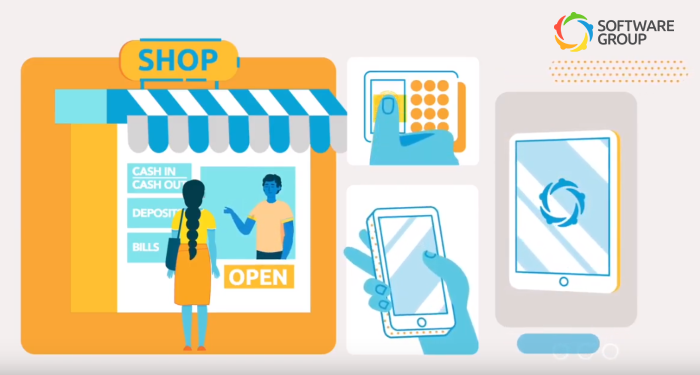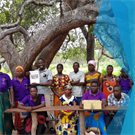Today technology can transform any merchant shop or even a post office into a bank.
It is no surprise that third-party agents have become a crucial part of the digital financial service ecosystem, especially in developing markets.
Agents have become the channel of choice for many customers due to their proximity and convenience.
The growing acceptance of the agency banking model and self-service channels has even led to the closure of ATMs at some banks.
Financial institutions have started expanding agents’ portfolio beyond basic cash in/out into customer onboarding, digital loans and more.
What is Agency Banking?
A quick-to-market strategy for financial service providers to scale their points of service via a network of 3rd-party agents.
With the help of agency banking software and mobile devices with biometrics, financial institutions enable agents to deliver services on their behalf - such as cash in/ cash out, balance inquiries, digital loans, bill payments, and more.
An Agency Banking Example from Ghana
To be able to scale quickly, Fidelity Bank Ghana realized that digitization is the road to follow. The bank leverages an agency strategy as part of their plan to increase their customer base five-fold. Read the Success Story.
The Benefits of the Agent Banking Model
Branchless Reach into Unbanked or Underserved Markets
1.6 billion people and 200+ million MSMEs around the world do not have access to basic financial services, according to the World Bank.
At the same time, current financial services do not adequately meet the needs of many in terms of convenience, proximity, and affordability, leaving them financially underserved.
In the developing world, markets are fragmented and a large part of the population is dispersed. Financial literacy is still low, especially among low-income segments, branch penetration is scarce and credit bureau coverage is insufficient.
Financial institutions realize the lack of sufficient service points in remote and rural markets, but new branch and ATM infrastructure costs are prohibitive, especially considering the high-volume, low-value transactions, specific for such markets.
The consequences are congested branches and limited scalability opportunities.
These are some of the challenges which a local trusted agent network could meet, aiding financial organizations in their successful outreach endeavors.
Cost-Efficient Distribution Channel
Gone are the constraints of physical infrastructure.
With agency banking, financial institutions can expand their business while avoiding the high-capital investment and complexity involved in opening and running new branches or ATM networks.
Operational costs can be reduced further by limiting paper-based processes and decreasing fraud and cash-handling risks.
Maintaining a physical branch is on average 25% more expensive than maintaining an agent network (IFC).
Thanks to agents, financial service providers can compete smartly and efficiently – cross-sell new value-added services, distribute priorities across own and agent units, and achieve competitive pricing based on economies of scale.
Enhanced Customer Experience
Аgents are a natural extension to a financial institution’s business.
Instead of traveling for hours to a branch, previously unbanked or underserved customers can now safely visit agents in their own proximity and convenience, at extended service hours.
The ability to deposit and withdraw funds, to make loan repayments, pay bills, even with no formal ID thanks to biometrics, could be critical for customers at the bottom of the pyramid.
Located in bustling business areas and operating at convenient hours, agents become customers’ go-to financial service partner. They help acquire new customers, drive awareness about services, and provide assistance when needed.

Deposit Mobilization
With an agent nearby, customers will be more willing to secure their savings at a formal financial institution.
The cost savings derived from lower transaction fees and shorter travel times could encourage people to increase the usage of their accounts.
Consistent deposit mobilization is beneficial for financial service providers as it helps them lower the cost of funds and eventually decrease the cost of credit for end customers.
With the help of the agency banking model, banks and microfinance institutions can realize benefits from lower distribution costs and improved operational margins.
Brand Awareness and Trust
Agents are often even more trusted than formal branches, because of the comfort of interacting with a familiar local person.
With consistent user experience at every trusted agent touch point, clients feel satisfied and safe to perform the financial operations they need.
Trust in agents boosts overall community trust towards financial institutions, and speeds up their outreach results.
Accessible, reliable and quality services earn long-term customer satisfaction and loyalty with the financial institution.
Relevance and Fast Go-to-Market
In the face of a fast-changing market, increasingly challenged by mobile money providers, TELCOs and FinTech competitors, it is critical to stay relevant to the needs of different customer segments.
Thanks to digitalization, financial institutions can quickly respond to demand for new financial services by making them available across their agent network via mobile devices.
While digital products and processes are clearly the future, customers still seek convenient channels to convert their digital funds to cash, a service delivered by agents.
Embrace Success in Agency Banking with Software Group
Software Group’s Agency Banking Solution was built with one goal in mind – to equip financial service providers with everything they need to quickly launch, manage and scale a successful agency banking network. It is based on our best practices and lessons learned from deploying agency in the last 10 years in more than 15 countries.
Ready to seize the branchless banking opportunity? Contact us today.
Sources:
- World Bank’s Global Findex Database 2017.
- The State of Mobile Money in Sub-Saharan Africa, 2016, GSMA.
- DIGITAL ACCESS: THE FUTURE OF FINANCIAL INCLUSION IN AFRICA, 2018, IFC.






